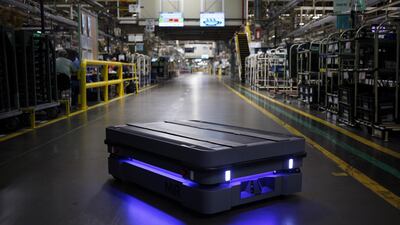Change has been a fascinating constant in the relationship between capitalism and consumption. It has underpinned theories of economists from Karl Marx to Joseph Schumpeter, and has been both bleak and uplifting. Sometimes, it has been incremental, but at others, it has been radical.
Today, it is very much the latter. Powered by the advent of data ubiquity, the emergence of cyber-physical systems and the rise of robotics, the Fourth Industrial Revolution – known as IR 4.0 – is well under way and undeniably radical in nature.
This global phenomenon is having a profound effect on issues such as growth, inflation, wages, productivity and employment. Going forward, it is also likely to have a profound effect on investment decisions – not just in terms of the rudimentary attractions of identifying "the next big thing" but in terms of the need to understand fully the sweeping transformation that is taking place.
England, the cradle of the Industrial Revolution, experienced a huge growth in output as the move to mechanised production took hold in the early 1800s. What it did not experience was an increase in real wages: between the turn of the century and 1830, in spite of soaring productivity, wages remained stagnant.
Today productivity is again diverging from real wages – and this time the divergence may be more extreme.
In addition, we are witnessing mounting and politically-charged tensions between the proponents of automation and those whose livelihoods it threatens. Research in the US has posited that voter behaviour in the 2016 presidential election may have been shaped by the anger of workers who lost their jobs to the march of technology.
Finally, we should remember that people are living longer and therefore need to work longer – a scenario apparently at odds with IR 4.0’s fundamental dynamics. Given the resultant magnitude of the geoeconomic and geopolitical implications, are there any realistic responses to this seemingly perfect storm?
Recent political events suggest many workers and voters expect populist politicians to repel the technological forces they regard as a threat to their way of life. Yet Luddite-like regression would overlook several problems, the most obvious of which is that the technology genie is already out of the bottle.
Priorities in the labour market are in a state of flux that clearly reflects IR 4.0’s influence, seen in the change in occupational skill sets and the transformation of how people work. A regressive response might bring short-term gains in countries where populism has secured a foothold, but its longer-term legacy could be a lasting lack of competitiveness. Any nation that willingly removes itself from the cutting edge is likely to be left in the dust.
This being so, which economic and political structure might be best equipped for the future? Respected political scientist Ian Bremmer has noted that China’s authoritarian-capitalist ethos is now being seized upon by other countries – India and Turkey among them – that see attractions in “building systems where government embraces commerce while tightening control over domestic politics and economic competition”.
Regardless of the underlying mechanisms of its model, a key component of China’s approach is to encourage innovation while at the same time preserving employment; and we can accept that such a balancing act is extremely desirable for all economies.
It is the long-term and the rational that should constitute the most promising response to the immensely complex set of interrelated challenges now confronting the global economy. Policies need to row with the megatrends – that is, with the tailwinds very much in their favour – which means fostering innovation while striving either to maintain or to restore people’s productive, wage-earning capacity.
As investors, then, we can expect IR 4.0 to lead to significantly greater national differentiation as populations and policymakers wrestle with the disruption and destruction to which radical innovation gives rise. Such effects are already manifesting themselves and are likely to be accentuated as some countries and companies adapt more quickly than others.
Among developed markets it is the US that seems most likely to remain at the frontier of transformational technologies. Europe presents considerable room for leading-edge innovation in low/moderate-scale entrepreneurial sectors. Japan should continue to excel in areas that reflect its own intrinsic and rare economic circumstances – notably robotics and the direct substitution of physical labour for manufacturing and, increasingly, services.
Asian economies, especially China and Korea, are likely to lead the way among emerging markets. India should retain leading high-tech software, consulting and other IR 4.0 segments but is also likely to lag in hardware and to cling to a very large agrarian economy. Russia looks set to stay at the forefront of military technologies, tools and hardware but seems unlikely to be a driving force in commercialisation.
More broadly, companies and sectors disrupted by novel technologies are likely to experience lower market shares, plunging profitability and rising credit risk and spreads. They should also see surging equity risk premia as their viability is questioned. This is hardly new, but the speed and extent of such shifts may well prove qualitatively different and perhaps even unprecedented.
Overall, the key lesson for investors is simple enough yet cannot be ignored: change is no longer a constant – it has become an accelerant. As such, it needs to be factored into current asset allocation decisions, as the myriad impacts and implications of IR 4.0 continue to unfold.
Arnab Das is a global markets strategist with Invesco

